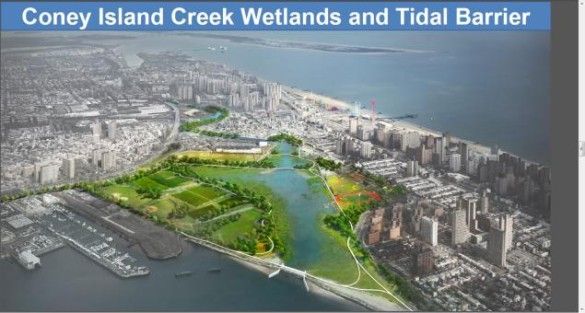Bloomberg Presents Coastal Flooding Plan In Face Of Predictions Of Grim Future

Rising temperatures, more hurricanes and torrential flooding; these are the increasingly extreme weather factors that New Yorkers are expected to live with over the next 50 years. The New York Times is reporting on the statistics released by the Bloomberg administration that indicate the onset of climate change and its effects on the city’s coastline in the coming decades.
The study released by Mayor Michael Bloomberg’s office states that the number of city residents living in the 100-year flood plain will nearly double from 398,000 currently estimated to be at risk, to 800,000 by the year 2050. Another disturbing statistic points to how future New Yorkers should expect more scorching summer days and rising sea levels:
Administration officials said that between 1971 and 2000, New Yorkers had an average of 18 days a year with temperatures at or above 90 degrees. By the 2020s, that figure could be as high as 33 days, and by the 2050s, it could reach 57, according to data collected by the New York City Panel on Climate Change…
In 2009, it projected that sea levels would rise by two to five inches by the 2020s. Now, the panel estimates that the sea levels will rise four to eight inches by that time, with a high-end figure of 11 inches. Between 1900 and 2013, sea levels in New York City rose about a foot, administration officials said.
Based on these numbers, it may become pointless for the city’s elderly to retire to Florida as New York becomes a sweltering tropical swamp by the middle of the century.
To fight this encroaching environmental nightmare, Bloomberg also laid out his $20 billion plan to protect the city’s 520 miles of coastline with a network of flood walls, levees and bulkheads. The ambitious plan would also cover improvements to the city’s power grid and infrastructure and making city bridges hurricane proof. Bloomberg was adamant that work on the project begin quickly.
“This plan is incredibly ambitious — and much of the work will extend far beyond the next 203 days — but we refused to pass the responsibility for creating a plan onto the next administration. This is urgent work, and it must begin now,” the Times reported Bloomberg saying.
To put the $20 billion price tag in context, the entire New York City annual budget is approximately $70 billion.
With over 250 recommendations, the large plan is only likely to grow in cost and scope if enacted. An example of this is the proposed construction of “Seaport City,” which would be built just south of the Brooklyn Bridge. The purpose of Seaport City would be to remodel Battery Park City and protect lower Manhattan from flooding. The cost of Seaport City is not figured in the initial $20 billion estimate but is expected to cost billions more.
To reach the minimum $20 billion cost of the project, the city would have to raise $5 billion. As much as $15 billion is already covered by federal and city money already allocated via the Sandy aid package approved by Congress. Bloomberg believes that the cost to protect New York now will far outweigh the cost of restoring New York after a future storm 30 years from now, which he estimates could cost the city upwards of $90 billion. Superstorm Sandy cost the city an estimated $19 billion.
More locally, the city would be planning to install a series of wetlands and tidal barriers to Coney Island, illustrated below.

All in all, if enacted, Bloomberg’s plan would radically alter the landscape of New York City, transforming its landscape and coastline. The cost would be enormous, but given the extreme weather changes facing the city in the coming decades, the investment might be well worth the cost and effort.
You can read the entire plan here.



